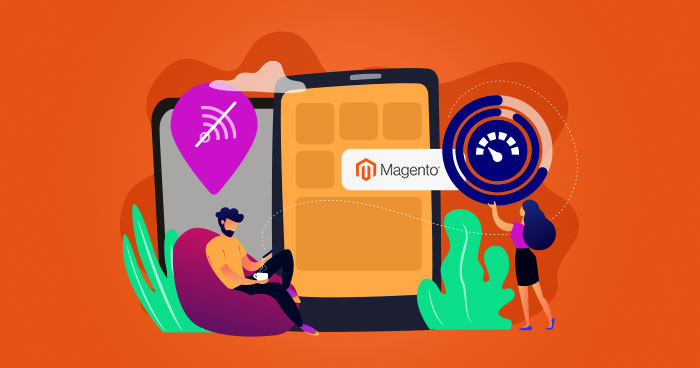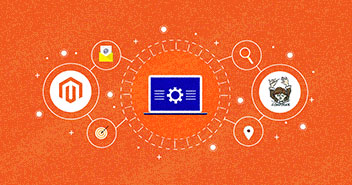
An excellent user experience is one of the many factors necessary for running a successful online business. To keep up with this, you must follow recent technological trends, like progressive web apps (PWA).
Can a PWA be an alternative to a native app? In some cases, it can be, especially in ecommerce. It lets online merchants focus on attracting visitors to the websites and encouraging them to buy items rather than downloading a native app.
That’s why many ecommerce platforms like Magento enable PWA creation. This article will focus on Magento PWA, its advantages, requirements, cost, and alternatives. We’ll analyze how to build the solution with ecommerce Magento PWA themes, extensions, and solutions.
- What is Magento PWA?
- What to Know About PWA
- Why Does Your Ecommerce Store Need Magento PWA
- Challenges with Magento PWA
- Magento PWA Requirements
- Methods to Develop a Magento PWA Site
- Magento PWA Solutions and Their Alternatives
- Magento PWA Development Cost
- What Magento Experts Have to Say About Magento PWA?
- Conclusion
What Is Magento PWA?
A progressive web app (PWA) roughly means a mix of a website and a native app. It’s a web app that provides a native-like experience with enhanced UI/UX, rapid loading, and discoverability by search engines. And it supports push notifications like native apps. At the same time, as PWAs are basically website shortcuts, memory consumption is minimal. You can compare the PWA and native app on the AliExpress example:

As you can see, the difference between the two is insignificant and lies in: the menu position, the “Chat” button at the bottom, and the search appearance. Apart from that, the PWA is just as convenient on mobile phones as the native app.
Such applications are also known as a variation of single-page apps (SPAs). They are opposite to traditional web architecture and are based on a headless commerce approach. This concept is about separating the frontend from the backend so they communicate via an API. The website then becomes more agile to the introduced changes. A PWA is thus more adaptable as the frontend and backend are less dependent on one another.
Experience the Cloudways Magento 2 Demo Store – No tech skills needed!
Experience a fully functional Magento 2 store built on top of renowned Cloudways hosting to deliver the fastest speeds.
What to Know About PWA
The term PWA appeared on Google in 2015. Google popularized this type of web app when it turned mobile-friendliness into a ranking factor. That’s why many website owners started to look at PWAs as a solution to boost search engine optimization (SEO), among other things.
Renowned brands that developed PWAs include AliExpress, Debenhams, Jumia, and more. The list is constantly updated as the share of mobile commerce grows yearly. According to Insider Intelligence, mCommerce volume will account for 42.9% of eCommerce in 2024 and total $620.97 billion.
Discover a Smarter Solution!
Unlock the power of PWA for Magento with Cloudways’ forward-thinking hosting and development environment.
Let’s take a look at Lancôme. The beauty brand wanted to provide clients with an impeccable user experience. The team understood the native app is more suitable for frequent visitors, while satisfying prospects on all devices was essential. So they rebuilt the website as a PWA and saw the following improvements:
- conversion rate increased by 17%;
- bounce rate dropped by 15%;
- mobile sessions grew by 51%.
Below is an illustration of the Lancôme PWA:

Why Does Your Ecommerce Store Need Magento PWA
Features of Magento PWA
PWA technologies work together to enhance a Magento store. Here are some of the benefits you can expect:
- Rapidity. Client-side rendering makes this possible. When a user visits a Magento 2 PWA, the browser sends a request to a server through APIs, which returns HTML with a link to JS files. The browser builds page templates without dynamic content. These templates are cached and don’t need loading when the user opens other pages. The backend sends only the required data, which creates less server load, and greater speed.
- Lightweight app. You may have noticed how many apps remain unused on your phone. At the same time, they take up much storage space, requiring you to delete other files. What if clients visit the store once a month or even less often? They will most certainly remove the app after making an order. So all the efforts to build a native app go in vain. PWAs are less demanding in terms of memory consumption. Their weight is measured in KBs compared to MBs for native apps.
- The Add-to-Home-Screen feature. How do you install native apps? Right, you go to the App Store or other marketplaces to find the needed solution and place an order. A PWA Magento 2 removes this unnecessary step, allowing you to purchase from the browser and save the link on the home screen.
Look at how this function works on the Eleganza website.

- It’s like being in an app. PWAs are not only exceptionally fast but also have great UX features. That’s why PWAs feel like native apps. The solution is more than a mobile-friendly website. It’s about taking all the best native apps’ features and implementing them on the web.
For example, the best PWA examples place buttons in the thumb-friendly zone (at the bottom of the screen). Navigation, fonts, and other elements follow the principles of simplicity and convenience.
- Push notifications. Push notifications are a crucial feature for ecommerce websites to re-engage visitors. You can send them to remind clients about an abandoned cart, notify them about hot deals, or introduce new collections. Subscribers will receive alerts on home screens.
Lower development costs. As you don’t need to pay separate Android and iOS teams to build an app, you can save money thanks to a PWA Magento.
How Magento PWA Improves the Magento Store
A Magento store can benefit from the conversion into a PWA in the following ways:
- The blazing speed and ease of installation can lower the bounce rate and increase mobile conversions.
- The native-like experience will add to user-friendliness. It will give the store a much-needed leg-up in the overcrowded market and encourage purchasers to return to the website.
- Other website metrics like session duration, pages visited per session, and cart abandonment rate will also improve.
- As PWAs remain websites, you can promote the store in search results, gain backlinks, and drive visitors from other resources.
What Challenges Might You Face with Magento PWA?
Of course, PWAs have their restrictions as well. It’s hard and time-consuming development, even though you need one solution and team for all operational systems. It may require as much effort as a native app or website optimization. So it’s up to you to choose where to invest money.
Another challenge to bear in mind is access to hardware features. Native apps integrate with a particular software environment. A native iOS app supports Apple-specific features like Face ID, and Android and Windows apps have other hardware properties.
Progressive web apps must cope with several limitations with the access to GPS, camera, contact list, calendar, mobile payments, fingerprint sensor, and others. How much access they have depends on the OS. For example, Android is less hostile to this solution and updates its environment faster than iOS. It applies not only to hardware but also to push notifications.
Push notifications work in Chrome, Opera, Safari, and Mozilla and are usable on Android but have troubles with iOS. Technological advancements will mitigate this issue with time, but you should consider it for now.
Cached files don’t last long. If users don’t open the PWA for a long time, the previously downloaded files will vanish, while the shortcut will remain.
Magento PWA Requirements
PWAs need several prerequisite components, including:
- Service workers to ensure a seamless experience. It’s a client-side JavaScript file running in the background, which is responsible for caching static files and requests, sending push notifications, and updating content. The app loads faster as the previously saved files are in the cache. And you may be sure the content will appear on users’ screens even during an unstable Internet connection.
- Web app manifest, which is a JSON file with the description of how the app should behave after installation on a device. It contains the name, author, how icons should look, etc.
- App shell architecture presents a page skeleton while the rest of the content is loading. This structure is a static page in HTML, CSS, and JavaScript. It’s what remains after you remove all dynamic content, i.e., everything that changes from page to page. The screenshot from Sophie Conran below demonstrates how it works.

- Transport Layer Security (TLS) is a protocol to encrypt the communication between web applications and servers and guarantee security and authentication. The PWA should use HTTPS. Consumers entrust loads of personal data to online stores: names, addresses, and, most importantly, credit card numbers. The way to protect this data is to provide a secure HTTPS connection.
- Application programming interface (API) as a communicator between the frontend and the backend. It’s another protocol, a set of rules on how the two parts will work together. APIs use various languages, like GraphQL.
- From the UI/UX point, PWAs rely on the pop-up working principle. It involves opening a new pop-up for new action. The user stays on the same page with the ability to swipe the overlaying page.
What Methods Can You Use to Develop a Magento PWA Site?
You need to determine the level of freedom you want to have when building a Magento PWA. Would you prefer to make it:
- from scratch by utilizing modern frameworks like React.js, Vue.js, or Angular.js;
- with premade themes;
- by installing add-ons and extensions?
Through Magento 2 PWA Extension
A straightforward way to add PWA features to the store is by installing various extensions. They enable you to configure site search, navigation, checkout, gift cards, etc. The website becomes more responsive and user-friendly and doesn’t involve much effort in custom coding.
However, most add-ons require you to have a PWA theme installed. It’s not a sufficient solution for building a PWA, so you can just extend existing functionality. Amasty offers a bunch of extensions for Magento 2 PWA. You can preview and customize the add-ons, as seen in the screenshot below.

Through Magento PWA Frameworks
This option requires substantial experience in web development but enables you to customize the store however you want. It suits those who want a unique website and non-standard capabilities. A website or application’s success begins with choosing the best solution. At this stage, we should mention such frameworks for a Magento PWA as React.js, Vue.js, and Angular.js. The first two variants are the most widespread in ecommerce.
React.js
React is a flexible and easy-to-use Javascript library for building user interfaces (UIs), creating SPAs and PWAs from scratch, or customizing themes. It is also sometimes referred to as ReactJS or React.js.
Vue.js
Vue.js is another Javascript library for creating UIs and SPAs. It’s open-source, developer-friendly, and lightweight. Coders can develop projects from the ground up, access rich official libraries, and accelerate rendering with its virtual DOM.
Angular.js
Angular.js is an open-source Javascript library to simplify development and testing. Introduced in 2010 and supported by Google, it’s flexible and lets you customize it to meet your needs. Some of its pros include two-way data binding (autonomous data synchronization), improved server performance, and faster application prototyping.
Through a Magento PWA Theme
A theme is a way to convert the website into a PWA with pre-designed web pages and coding tools. It’s a JavaScript frontend that can communicate with the backend via API. A theme also has a single code base for desktop and mobile. You can modify it to fit your needs despite a ready-to-use design.
Magento PWA themes may lack some functionality, contain bugs, and require updates and customization. Nevertheless, themes have all the needed solutions for making a PWA storefront. They reduce the time and effort of coding so that the website goes through the optimization process faster.
Magento PWA Solutions and Their Alternatives
Let’s discuss some of the most notable Magento PWA themes and instruments, such as Magento 2 PWA Studio, Scandi PWA, and others.
Magento PWA Studio

Magento PWA Studio is a toolkit for developers to streamline the process of creating progressive web applications. It’s an official Magento solution, enabling PWAs for this eCommerce platform. What does the tool include? There are ready-made components and a front-end architecture. It reduces the chances of mistakes at the initial stage, affecting further work.
One of the PWA Studio Magento 2 benefits is that it’s not monolithic. You can take just part of the code instead of the whole package.
The PWA Studio comes with a configured application builder and setup service workers. It also has numerous app elements that you can employ as they are or customize to your needs. Plus, Magento does routing and caching for you.
The downsides to consider are:
- the need to cut the excessive code that developers don’t apply to the store;
- a high probability of using unnecessary abstractions or bugs;
- the time to study the existing solutions to avoid creating what already exists.
Scandi PWA

Scandi PWA is the first open-source ready-to-use PWA Magento 2 theme. It’s not a storefront, but a theme, which is easier to install and apply to the store. The toolkit provides different functionality and components for developers to use and customize. Scandi PWA can be placed on top of any M2.3 or newer project. You may face challenges with implementing it on other platforms or older Magento versions.
Scandi PWA doesn’t require infrastructure changes. It makes the theme developer-friendly, allowing for fast PWA deployment with all the benefits.
The theme uses GraphQL as an API to deliver data from the backend and send requests from the frontend. The frontend works on ReactJS, which inputs data into placeholders.
Other Alternatives
Do you want more options for developing a PWA storefront? Here are five popular providers. They also let you create a standardized app with essential PWA features.
- Vue Storefront, an open-source framework for various ecommerce platforms. It employs Vue.js for building user interfaces. The theme may lack documentation, however, complicating development and maintenance. It also doesn’t provide any information on how it will behave after the Magento update.

- CedCommerce, an ecommerce platform with a Cenia PWA theme. It relies on ReactJS, GraphQL, and PWA Studio and constantly upgrades to provide a better user experience.

- SimiCart is another service with a responsive PWA theme Siminia. It’s free and based on PWA Studio, promising its clients to speed up loading by three times, boost SEO, and ensure an app-like experience.

- Tigren PWA lets you transform the Magento store into a PWA. The theme is based on Magento PWA Studio, so customers shouldn’t have any compatibility issues due to Magento upgrades. It also provides all the needed features for high-quality eCommerce functionality.

- GoMage is our fifth Magento 2 PWA theme on the list. It has a drag-and-drop builder to streamline development. The theme lets you tweak the store as you want, integrates with Google Analytics, and offers features for online promotions (like coupons, upsells, or automated newsletters.)

Magento PWA Development Cost
Pricing for a Magento 2 PWA depends on your needs. It may start from $68,000 for basic store development and reach $127,800+ for advanced options like custom UX/UI design, endless support, and other individual services. It also varies according to the state of the original website. The more you customize the store, the more you’ll need to pay.
Every development agency charges its own fees, so you need to consider their proficiency and portfolio before opting for someone’s services. Note that the geographical factor also plays a vital role here. On average, an hourly rate ranges from $25 to $70.
The total amount of hours also depends on how much work the conversion will take. If you want a custom PWA, a development stage can be accomplished in 1000 – 2000 hours. The process will involve transforming an existing Magento website and adding standard functionality.
What Do Magento Experts Have to Say About Magento PWA?
Magento service provider Onilab has been working on Magento migration, development projects, and building progressive web apps (PWAs) for over eight years. As Magento experts, they consider developing Magento PWAs a worthwhile investment.
This move will prepare the website for future demands. How? A PWA is based on a headless architecture. It means you’ll faster adapt the store for numerous touchpoints as it will be more flexible with split frontend and backend.
Consider various challenges with developing this solution. If your goal is a unique PWA storefront with customized elements, you need an experienced team and more time. Do you want to dive into the Magento PWA as soon as possible and standard features are enough? Then, you should opt for ready-made themes. In any case, even the perfectly built themes will require some modification.
Online store owners can provide more native app like experiences with PWA enabled Magento frontends, such as “enabling content while offline” and “use of native device features like phone notification system” – such as alerting the user if the battery is low and the transaction may not complete with the remaining battery life available, so can prompt the user to save what they have done so far.
These native app-like experiences are anticipated to contribute to raising conversion rates.
Progressive Web Applications (PWA) reshape the mobile landscape across industries, with ecommerce coming first in line. Here is the thing about PWA – it offers a kind of unique user experience to ecommerce websites bringing native mobile app and web app development under one roof.
Incorporating PWA into Magento-based websites, merchants get a single website version that loads fast, launches from a mobile device home screen, sends push notifications, operates on low-quality networks and even offline.
What is more, PWA development costs are 5-6 times lower compared to native mobile apps. Any downsides? Seriously, we haven’t traced any so far.
For a Magento developer, it’s effortless to get started with Magento PWA. If you’re a dev working with the PWA, you don’t need to know much about the Magento core framework, just the APIs and how to send and request data to and from it.
Magento’s PWA is really a very progressive & ambitious step for any store owner. But necessary, if you want to be one step ahead of the competition.
The cherry on top: Visiting the store’s PWA site on mobile and desktop will prompt the user (after a predetermined time) to download your site as a *local application*! That means your store website is easily accessible and can work offline for specific pages.
Conclusion
PWAs are web applications installed on devices right from the browser. Many well-known brands like Puma, Starbucks, AliExpress, and Pinterest have adopted this technology for their websites.
Creating a native app for various OSs means encouraging visitors to download an app in the first place. And only after that to buy your goods. Isn’t it an unnecessary step on the purchase journey?
For an online merchant, it’s more important to upgrade the website and focus on converting visitors into customers. A PWA will be a winning solution for retailers with long-term goals. It ensures better website rankings due to a polished user experience, rapid loading speed, and finer usability. It also saves you time and money on promoting the app in the app store.
Jyotishna Kumari
Jyotishina is the Magento Community Expert at Cloudways and has 4 years of experience in web development. She has worked on e-commerce sites since the turn of the millennium and was working with Magento before version 1 was released. She loves to travel and explore new ideas whenever she finds time. Get in touch with her at [email protected].


